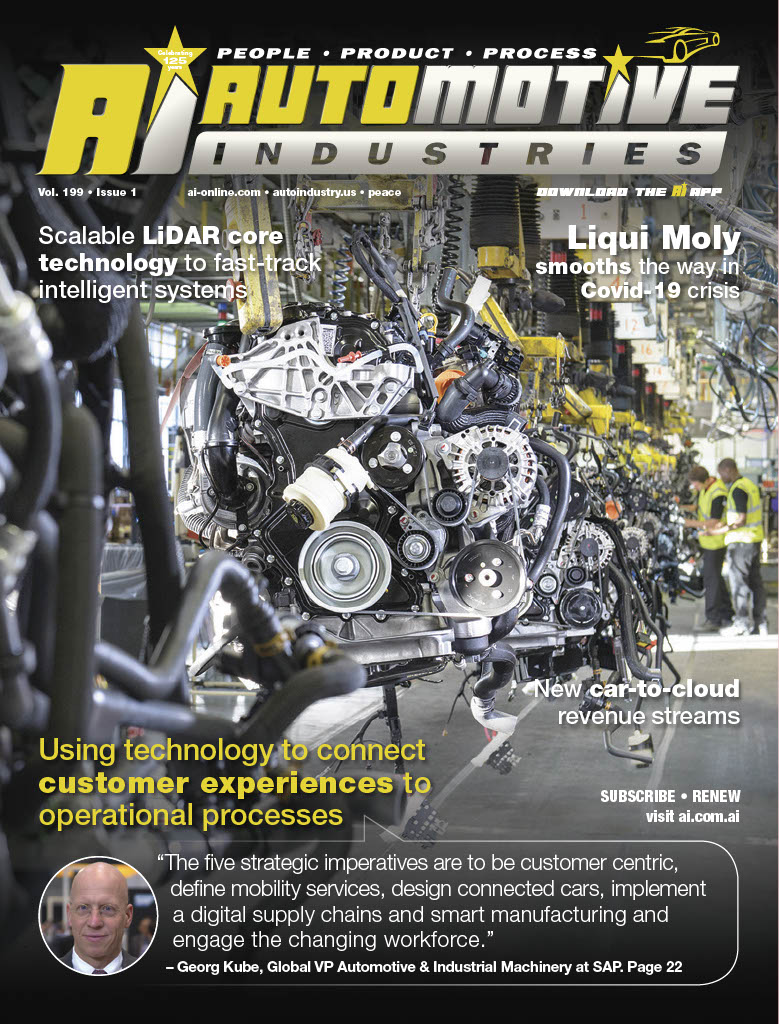
Automotive manufacturers are having to adapt to new customer expectations, trends and technologies while at the same time maintain the profitability of existing operations.

Paradoxically, they have to put their existing processes out of business in order to stay in business in the face of new competitors and changing market expectations.
Automotive Industries (AI) asked Georg Kube, Global VP Automotive & Industrial Machinery at SAP what are the top priorities for automotive companies wanting to transform their businesses.
Kube: We have identified five strategic priorities through an advisory council which we run with the major companies in order to develop what we call an intelligent enterprise framework.
The five strategic imperatives are to be customer centric, define mobility services, design connected cars, implement a digital supply chains and smart manufacturing and engage the changing workforce The first priority is to be customer centric. Historically, OEMs have left the direct interaction with customers largely to the retailers. That is shifting big time. OEMs and even suppliers recognize that they need to establish a direct link with the end consumer, in order to identify what they really want.
From this came the realization that all consumers want mobility but that might not mean owning a car. This means that OEMs have to decide their strategy. It could be to focus on new mobility services, aggregating services delivered directly through their car as a platform, or managing fleets. Whichever strategy they follow, designing connected cars will still be at the core. But depending on their focus it will require different development models, processes and capabilities. The fourth priority is implementing a digital supply chain and smart manufacturing.
This is the ability to execute a completely new level of automation and customization on the production line using intelligent technology. The fifth priority is engaging the changing workforce. Companies have to get the new generation on board, and then keep them. This means providing a working environment in which millennials can thrive.
AI: Which technologies will help automotive companies respond to market trends?
Kube: The most important are those technologies that enable enterprises to be intelligent and drive automation.
These include big data management, IoT (the Internet of Things), AI (artificial intelligence), machine learning, blockchain, augmented reality and 3D printing. AI: What is the best approach towards Industry 4.0?
Kube: Industry 4.0 helps manufacturers with two priorities, which to my mind, are mutually exclusive. One is where you have a product manufactured to stock or in large quantities.
Industry 4.0 helps make this process as efficient as possible through totally autonomous, high-volume production 24/7. The other is to deliver a product that is highly customized. Then you need to deliver an experience and product that is highly individualized, but must still be produced at a cost close to a stock item. This requires automation and flexibility. Companies should be really clear on what it is that they are trying to achieve. One means connecting the supply chain with the factory. The other requires connecting customer demand directly into a manufacturing process. Both use Industry 4.0 to focus on the customer, reinvent manufacturing using intelligent technology, assets and processes, and ensuring visibility of supply and manufacturing throughout the entire company.
AI: How do you expect production to change?
Kube: I believe the markets will shift towards more individualized products. Here in Europe if I order a car, I am selecting the color, the seams of the seats, etc. That is currently not as typical in other places such as the US, or China. But I believe customization is the way forward, and that will require manufacturing to manage many different configuration options. This means that production lines and supply chain integration will become more complex. So, I think we will see a shift from line to modular production, as there is a point where all these options cannot be managed on a single line in a cost-efficient manner. Audi tried to do that in Hungary for the e-tron, thinking it was best suited to modular production. In the end those plans were premature, but I think modular production is coming.
AI: How does the digital twin add value for manufacturing companies?
Kube: Industry 4.0 principles and intelligent technologies means being able to have machines talk to one another and make autonomous decisions based on real time data. If I want to simulate how a certain product moves through a production process then I need to have a digital representation not only of the product, but also of the production process. Digital twins are exact replicas of the assets, and form a big part of Industry 4.0 philosophies. Using a digital twin, you can simulate what happens to productions lines under different processes and tweak as you go. However, you also can use the digital twin to improve collaboration, access to product 3D manuals, assembly or disassembly videos, that are all accessed through the digital twin. Of course, the digital twin helps enables new business models like predictive maintenance.
AI: How is the focus on the customer and employee experience transforming the automotive industry?
Kube: You will find that organizations which have high employee satisfaction, also have high customer satisfaction. Using our customer experience product Qualtrics, an OEM in Australia found a direct correlation between customer satisfaction with a dealership and the level of employee satisfaction.
AI: How are SAP and Qualtrics helping the automotive industry unlock value in the experience economy?
Kube: Your customer should be the most important part of your strategy because they determine your success. In the past feedback markers were widely spaced in time. Car purchases were often many years apart. Service visits were often annually.
That made it really hard to get real time feedback on what customers really think. Those models are changing. The closer you can get to the “in the moment feeling”, the better. One of our customers has implemented a process through which their clients receive an email questionnaire immediately after the service. If the customer is unhappy, they get a call within two hours. That is the benefit of real-time CRM. We believe that companies need to have these systems because it is becoming a different world where the experience is key.
AI: How can companies combine X (experience) and O (operational) data to deliver amazing customer service?
Kube: The X data is the feedback of the service. “They didn’t even clean my car.” And O data would be “the customer was here on that day and time; we did this and here is the profitability of that specific service”. If you only look at the operational data it seems that they did the right work at the right margin. However, when you include the X data, you realize that the customer is not happy. Bringing the two together is really important, as it may tell you that your profitability is flawed by a bad experience and maybe you need to upgrade the experience or adjust your price.
AI: What can we expect next from SAP?
Kube: SAP will continue to serve the automotive market from end to end, from OEMs through suppliers, to dealers. We will continue to look at the whole ecosystem, from R&D through manufacturing to servicing and new mobility models.











More Stories
What You Should Know Before Filing a Car Accident Claim
Injured in a Car Accident in St. Louis? Here’s What to Do Next
Historic Sportscar Racing (HSR) and Goodyear Announce Multi-Year Partnership